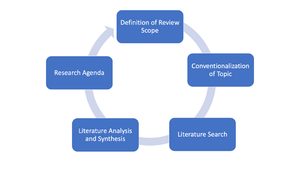Literature Review according to vom Brocke et al
Process description
The literature review process is essential in any kind of research and its importance has never been in doubt. A literature review seeks to uncover the sources relevant to a topic under study and, thus, makes a vital contribution to the relevance and rigor of research. With the rapidly increasing number of potentially relevant publications, its difficulty is increasing as well. The following process proposed by vom Brocke et al.[1]
supports researchers in crafting an effective literature review and guidance on how to deal with the increasingly dynamic context of information systems (IS) research.
Definition of Review Scope
Description
In order to clearly define the scope of a review, the established taxonomy for literature reviews presented by Cooper[2] is used. Cooper’s taxonomy is comprised of six constituent characteristics:
- Focus: Most literature reviews focus on research outcomes, research methods, theories, and/or applications.
- Goal: Common goals of literature reviews include summarising, criticizing, and/or integrating findings.
- Organization: For organizing a literature review, Cooper suggests a historical, conceptual, or methodological structure.
- Perspective: Reflects whether a certain position is espoused or not.
- Audience: Particularly determines the writing style of the author(s).
- Coverage: Four levels of coverage can be distinguished
- Exhaustive: including the entirety of literature on a topic or at least most of it.
- Exhaustive with selective citation: Considering all the relevant sources, but describing only a sample.
- Representative: Including only a sample that typifies larger groups of articles.
- Central: Reviewing the literature pivotal to a topic.
Examples
Further Readings
Brocke, Jan vom; Simons, Alexander; Niehaves, Bjoern; Niehaves, Bjorn; Reimer, Kai; Plattfaut, Ralf; and Cleven, Anne, "RECONSTRUCTING THE GIANT: ON THE IMPORTANCE OF RIGOUR IN DOCUMENTING THE LITERATURE SEARCH PROCESS" (2009). ECIS 2009 Proceedings. 161. http://aisel.aisnet.org/ecis2009/161
Cooper, H.M. (1988). Organizing knowledge syntheses: A taxonomy of literature reviews. Knowledge in Society, 1, 104-126.
Conceptualization of Topic
Description
In this activity, attention should be paid to the fact that a review must begin with “a broad conception of what is known about the topic and potential areas where knowledge may be needed”[3]. Therefore, working definitions of the key terms should be provided at this point. This can be achieved by consulting “those sources most likely to contain a summary or overview of the key issues relevant to a subject,”[4] such as seminal textbooks, encyclopedias, or handbooks. A reasonable way of identifying key concepts is represented by concept mapping, which also provides the opportunity to uncover relevant search terms that can be applied in the subsequent literature search.
Examples
Introducing working definitions of terms, e.g. ‘literature review’
Further Readings
Brocke, Jan vom; Simons, Alexander; Niehaves, Bjoern; Niehaves, Bjorn; Reimer, Kai; Plattfaut, Ralf; and Cleven, Anne, "RECONSTRUCTING THE GIANT: ON THE IMPORTANCE OF RIGOUR IN DOCUMENTING THE LITERATURE SEARCH PROCESS" (2009). ECIS 2009 Proceedings. 161. http://aisel.aisnet.org/ecis2009/161
Literature Search
Description
The search process involves database, keyword, backward, and forward search, as well as an ongoing evaluation of sources. As they have typically been peer-refereed before publication, it is commonly recommended to focus on articles published in scholarly journals or proceedings of renowned conferences. Contributions in conference proceedings are usually considered lower and less mature than those in journals.
One challenge definitely lies in identifying proper databases. We propose to search those databases (Conceptualization of Topic) providing access to the leading IS journals (identified in Definition of Review Scope) – a proceeding that finally allows for ensuring that all the top-tier sources are included in the review. The identified databases have then to be queried on the basis of a keyword search.
Examples
Further Readings
Brocke, Jan vom; Simons, Alexander; Niehaves, Bjoern; Niehaves, Bjorn; Reimer, Kai; Plattfaut, Ralf; and Cleven, Anne, "RECONSTRUCTING THE GIANT: ON THE IMPORTANCE OF RIGOUR IN DOCUMENTING THE LITERATURE SEARCH PROCESS" (2009). ECIS 2009 Proceedings. 161. http://aisel.aisnet.org/ecis2009/161
Literature Analysis and Synthesis
Description
All the collected literature on a topic has to be analyzed and synthesized. For the analysis, a concept matrix, as developed by Salipante et al. (1982) and adapted for IS literature reviews by Webster and Watson[5], can be used, which subdivides topic-related concepts into different units of analysis. This allows for arranging, discussing, and synthesizing prior research.
Examples
Further Readings
Brocke, Jan vom; Simons, Alexander; Niehaves, Bjoern; Niehaves, Bjorn; Reimer, Kai; Plattfaut, Ralf; and Cleven, Anne, "RECONSTRUCTING THE GIANT: ON THE IMPORTANCE OF RIGOUR IN DOCUMENTING THE LITERATURE SEARCH PROCESS" (2009). ECIS 2009 Proceedings. 161. http://aisel.aisnet.org/ecis2009/161
Webster, J. and Watson, R.T. (2002). Analyzing the Past to Prepare For the Future: Writing a Literature Review. MIS Quarterly, 26 (2), xiii-xxiii.
Research Agenda
Description
As the final activity, the synthesis of the literature is further expected to result in a research agenda, comprised of sharper and more insightful questions for future research. The research agenda provides the basis for extending the review in order for the IS community to keep up-to-date and it may be developed based on the proposed concept matrix. Certain fields of the matrix, which remain ‘blank’ during a literature study, often highlight research areas that are significantly under-researched.
Examples
Further Readings
Brocke, Jan vom; Simons, Alexander; Niehaves, Bjoern; Niehaves, Bjorn; Reimer, Kai; Plattfaut, Ralf; and Cleven, Anne, "RECONSTRUCTING THE GIANT: ON THE IMPORTANCE OF RIGOUR IN DOCUMENTING THE LITERATURE SEARCH PROCESS" (2009). ECIS 2009 Proceedings. 161. http://aisel.aisnet.org/ecis2009/161
References
- ↑ Brocke, Jan vom; Simons, Alexander; Niehaves, Bjoern; Niehaves, Bjorn; Reimer, Kai; Plattfaut, Ralf; and Cleven, Anne, "RECONSTRUCTING THE GIANT: ON THE IMPORTANCE OF RIGOUR IN DOCUMENTING THE LITERATURE SEARCH PROCESS" (2009). ECIS 2009 Proceedings. 161. http://aisel.aisnet.org/ecis2009/161
- ↑ Cooper, H.M. (1988). Organizing knowledge syntheses: A taxonomy of literature reviews. Knowledge in Society, 1, 104-126.
- ↑ Torraco, R.J. (2005). Writing integrative literature reviews: Guidelines and examples. Human Resource Development Review, 4 (3), 356-367.
- ↑ Baker, M.J. (2000). Writing a Literature Review. Marketing Review, 1 (2), 219-247.
- ↑ Webster, J. and Watson, R.T. (2002). Analyzing the Past to Prepare For the Future: Writing a Literature Review. MIS Quarterly, 26 (2), xiii-xxiii.
